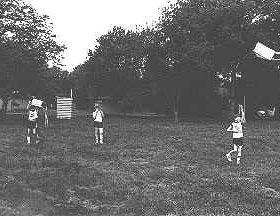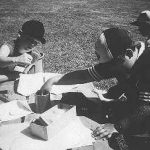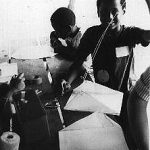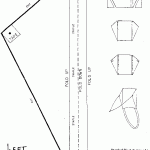Chapter Eight –
Hey Mister! Can I Make One Of Those?
 In the last chapter of Tangents and Trivia I talked about making a lot of kites in a train. During the 1980’s I was also one of the two main Kids Kite Class Instructors for the Chicago Land Sky Liners Kite Club. If you will remember in one of my earlier T & T’s I talked about how a kite club could gain needed revenue and exposure for their kite club by offering to do kite making workshops for a variety of groups. The Sky Liners never did anything half way, and they had a pool of 3.5 million people to advertise their classes to. We were very busy!
In the last chapter of Tangents and Trivia I talked about making a lot of kites in a train. During the 1980’s I was also one of the two main Kids Kite Class Instructors for the Chicago Land Sky Liners Kite Club. If you will remember in one of my earlier T & T’s I talked about how a kite club could gain needed revenue and exposure for their kite club by offering to do kite making workshops for a variety of groups. The Sky Liners never did anything half way, and they had a pool of 3.5 million people to advertise their classes to. We were very busy!
In the 80’s I worked third shift at a print shop in the city; from 11:30 PM until 6:30 AM. This meant that I was free to do workshops during school hours. Charlie Sotich was retired (I really never knew Charlie when he worked for a living!) and was also available for these workshops. We made a pretty good team. And I learned a lot about kids, kites and aerodynamics from those classes. Many other Sky Liners helped when they could, but Charlie and I would sometimes log two or three classes a week during springtime every year.
The Sky Liners charged the school or organization that we did the workshop for, usually about one or two dollars per kid. This would vary with the materials we supplied or the ones that the school supplied. The cost was often based on what the organization could afford. Chicago School districts had funds for “Guest Instructors” but suburban schools usually did not.
Charlie and I never personally charged for our efforts, although toward the end we started charging the club for gas money. (Charlie and I would do a tank of gas a week for classes only!) The Sky Liners earned several hundred dollars every spring through these workshops.
What Kite Should We Use?
kids1.jpg (34159 bytes)The design that you choose for your workshop should be based on the group you are instructing: age, motor skills, and grade level. The type of kite is also determined by the time you have to give the class and the money that is available for materials for the construction.
Charlie Sotich came up with a kite design that became our standard Workshop kite. We called it the “Stapled Sled” (see diagram at end of this article). This kite was an evolution of several designs that originally came from a paper bag kite that Dave Checkley used with the Washington Kite Association back in the early 80’s.
Our version was basically a photo copied 11 inch by 17 inch piece of standard 20# white paper. The design and instructions were printed right on the kite. The spars are usually the most expensive material for a kite workshop. We solved this problem by including a portion of the printed design that needed to be folded and stapled. These two “stapled spars” added the rigid portion and substituted for any dowel rod or spars.
An interesting spin-off of the staples was that the process also helped determine the age group that was capable of making the sled. If the kid was too small to work the stapler, they were too young to make the sled. We used a pliers (squeeze type) stapler. The reason for using this type was that to operate the stapler the kids had to use BOTH hands to squeeze. With a table version stapler any child could just put a finger under the stapler and bang the top. OOPS! Stapled a finger?
Charlie altered the basic design several times over the years of kite workshops .
It flies beautifully. It flies without the tail; it flies upside down. IT FLIES! That should be the major goal of your workshop – get the kids to make something that works.
There are hundreds of workshop kite designs. BUT HEY! This is my article so I am going to discuss my favorite class kite. Besides, the type of kite that you choose is not quite as important as HOW you teach the kids and WHAT you teach them about building kites. Check out the local kite shop for books on kite making workshops. Margret Gregor and Wayne Hosking have really good books on the subject. The American Kitefliers Association has a very good handbook on kite workshops. Check the Web–there are about a million designs for workshop kites floating around in cyberspace.
What Do You Mean You Can’t Do It?
kids3.jpg (31525 bytes)One thing to keep in mind when you do a kite workshop is that you are going to “instruct” the kids on how they will make their own kite. Frequently at my own kite workshops I find that a child will use the dreaded phrase, “I CAN’T…”
From my own perspective, kite making for kids teaches many things, only one of which is the actual aerodynamics and mechanics of constructing the kite. It is also personal effort with tangible results! Self-reliance! Confidence in their own abilities! And mainly, the simple joy of flying a kite!
I make an effort to separate the kids from their parents at a class whenever possible. Kids tend to know which buttons to push to get their parents to do things for them. You will also find some parents that are absolutely positive that their child isn’t capable of doing this unassisted. The idea here is to give the child the learning experience, not to watch their parents make a kite!
The task of getting some kids to actually do the work can be a hard one. You have to be careful not to fall into the trap of doing the work for them. Remember that there are many kids in your class, do you want to make ALL of their kites yourself?
A little trick I have used with some success when a kid says, “I can’t…” is to tell a Star Wars story. Almost everyone has seen Star Wars and knows the scene when Luke Sky Walker is being taught to be a Jedi Knight by Yoda. Yoda instructs Luke to use the force to lift his X-wing fighter out of the swamp. Luke tries, but fails. He says “I can’t…” Yoda looks at him and says, “There is no such thing as CAN’T, there is only DO or DO NOT.”
I guess that some people think that I am a bit stiff at some of these classes when Ikids4.JPG (20803 bytes) tell kids that I will not make their kite for them. They MUST make it themselves. Oh sure, you have to show them how, but don’t do it for them. They can succeed if they are motivated to try. That is the real job of a kite class instructor. Motivate the pupils to try to do it themselves. Try showing how to tie a bridle connection on one side of a sled and urging the child to try the other side. NEVER say that they didn’t do it the right way, even if they have done it wrong. Compliment them for the effort and show them again, saying something like, “Good effort, try this,” or “Not bad, but here’s an easier way!”
In every group of kids there are one or two who immediately pick up on the construction technique. Get them to help the other kids. Teamwork is a good thing when it comes to kids. For one Cub Scouts kite class I used a diamond kite similar to my own ‘kite train’ version. I emphasized the “group” thing and before you knew it there were several Den trains flying on the field. Each kid made one kite and soon the group had a train. The next problem I ran into with that one was when they began to argue about who could hold it! Oh well, kids will be kids.
Where Am I Going To Get Some Help For All These Kids?
Charlie and I worked well as a team doing these classes. It’s always easier to have at least two people that know how to do the workshop kite. One can explain and demonstrate each step at the front of the class while the other wanders through the class and provides support.
Remember those parents you separated from their own children? They will do a much better job as wandering assistants as well. Here’s a trick that Charlie and I used to recruit parental help. When a family arrived at the class they would bring along that two or three year old son or daughter. This child will be too young to make the stapled sled. (Remember my stapler squeeze test.) I had another kite just for those “really” little kids. (See folding kite diagram at bottom of article)
The folding kite isn’t very difficult to construct, but it can take an hour for a three year old to decorate. When you see that little kid that is going to need help with the big sled, give them one of the folder kites and some crayons. This will keep them busy AND release that parent to assist you with the more advanced and older kids. After the infant is finished there are just two staples, a tail and a four foot piece of line YOU attach and the kite is finished, giving the toddler a sense of accomplishment (and keeping them out of your hair). Have a special table just for these ‘Really Little Kite Makers’. This will keep decorating equipment away from your other students until you are ready for them to color. (More on decoration later!) The folding kite really does fly well, too, a major requirement for any kite used in a workshop.
Red Braswell, the first AKA president came up with the Folding Kite design. I’m not sure that he invented it. Similar folding kites can be found in the Margaret Greger workshop books. Still, many thanks to Red from the thousands of little tikes that were introduced–successfully–to kiteflying through this kite.
Charlie and I once taught a kite workshop to some very severely retarded children at a special school in Chicago. They had virtually no controllable motor skills, certainly none to operate scissors or staplers. The folding kite came to our rescue. All the students decorated a kite, then Charlie and I went around the class and stapled the kite together. The class went outside and ran about with three or four foot lines on kites that really do fly. The school teachers said that this was the only class they ever saw that got participation out of ALL their pupils. Charlie and I received an award from the city of Chicago for that class. Personally, my reward was seeing a smiling kid in a wheelchair, laughing and smiling and trying like crazy to move his wheelchair fast enough to get the kite to fly.
But Mister, When Do I Get To Decorate My Kite?
This one is really easy for me to talk about. Do not allow the kids to decorate their kite until they are completely finished with the construction.
If you allow coloring or decorating before you are finished, some (many) kids will spend so much time decorating they will not finish the kite. Suggest that they finish decoration at home. OR save the coloring until the end of the class.
Remember that these are just children. Stay away from permanent markers, paints or anything that could get you into trouble with the parents due to of misuse by the kids. Suggest these and other decorating methods, but recommend them for home with adult (parental) supervision.
Do I Get To Fly My Kite Now?
In order for the learning process to come full circle the kite has to fly. If your workshop consists of outside flying time you should spend some time talking about kite safety.
I have tried –unsuccessfully–to convince kids that it is not necessary to run to get their kite to fly. It is a built-in genetic and ancestral urge. Do not try to stop them from running; rather, control how they run around. Try to slow them down. Show them by your own example, but don’t worry too much about the running. It’s been going on since cavemen flew rocks!
Try to emphasize finesse when launching and flying. This small stapled sled does not accept hard and jerky line control. Sorry guys, but the girls usually have better success here. Boys tend to want to force the kite to fly by sheer muscle and effort. Girls tend to take it all a little easier and have more success. Do not tell the young boys that though; it will get you into trouble!
But Mister I Want To Know More!
 In any kite class there are always one or two kids that really seem interested in kiteflying. They will ask more than the usual questions. They want to know about other kites. They will tell you about some other kite they have that may or may not work. They are interested.
In any kite class there are always one or two kids that really seem interested in kiteflying. They will ask more than the usual questions. They want to know about other kites. They will tell you about some other kite they have that may or may not work. They are interested.
This extra interest can come from one of the parents too. You can generate new kite club members and increase the interest in the hobby of kiteflying by being ready with answers for these budding fliers. Have AKA and kite club info with you. Let them know where and when your club flies locally. Have a list of kite books that you can recommend. You are an instructor and not just an assistant kite constructor.
I will frequently fly one of my own kites along with the kids’ workshop kites. I usually choose a big one or an exotic one. Impressing the kids helps to motivate them to continue in the hobby of kiteflying. One of the main tasks of a kite workshop is to instill the interest, joy and art of kiteflying into your students (or their parents).
How Many Kids Are There In That Class?
During the time that Charlie and I were doing kite classes in Chicago we lost track of how many classes and kids we actually taught. An annual gig was with the local Chicago Cub Scout summer camp. We went there on Mondays, Wednesdays and Fridays for one month (7 days) On each day we taught 15 kids (a den) kitemaking at each session which lasted 45 minutes. We then got 15 minutes off. This went on for six hours or about 650 kids.
We taught workshops at the Museum of Natural History in downtown Chicago and we taught kitemaking in a one car garage. The largest class we ever taught was a grammar school assembly of 450 kids. (We had to use a whistle to get their attention!) We taught a class once with only two kids showing up! We had a great time teaching thousands of kids the art, skills and joy of making and flying kites. We taught them many things about construction and aerodynamics. We taught them that kiteflying isn’t necessarily just for kids.
The most important thing we taught them was confidence in their own abilities. How to perform a task with minimum help and have the resulting object actually fly! We taught them to cooperate with each other and, somewhere along the way, we taught them to have a little fun with a project that was not connected to a controller or a computer game. (Don’t get me wrong; video games are okay but kiteflying wins in my book any day!)
What did Charlie and I accomplish for ourselves? Well there’s the satisfaction in helping all these kids to build and fly kites successfully. We helped to increase the exposure of kiteflying to Chicago and helped to increase the Chicagoland Skyliners Kite Club Treasury.
But one of the main things I gained from all these kite classes was PATIENCE and a talent for getting along with kids. (I picked up the nickname, “Uncle Al, the kiddies’ pal” after all these workshops.) Trust me, after doing a kite class with 25 unruly 12 year old boys, you either learn patience or you go crazy!
One thing I’d like to clarify before I close. Throughout this entire article I have referred to Charlie Sotich and myself as having conducted the workshops in Chicago. We were by no means the only Sky Liners that did these classes. My congratulations and appreciation goes to ALL the Sky Liners that worked so hard at all these kite classes and STILL DO!
Next Time In The T & T Zone!
The ultimate kite festival in my book has to be the American Kitefliers Association National Convention. So far I have been to nine of them. But the ultimate thrill of an AKA Convention is to be one of the hosts for one of these festivals in your own hometown. Next issue, we travel to Chicago and talk Tangents and Trivia about what I consider to be the BEST AKA National Convention of all time. WINDY CITY 1988
The Gang From Chicago Says, ” You Better Be Dere!”
Till Next Time… Good Winds, Al Hargus
Click on the small diagrams to see larger ones. Feel free to print these out, and teach a class!










